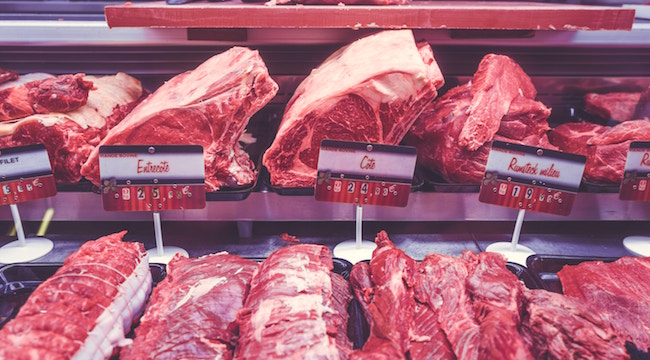
In the United States, we eat a lot of steak (though, to be fair, not as much as we used to). Back in the 1970s, beef consumption peaked at 90 pounds per American, every year. It’s been trending downwards since. Still, the numbers are staggering. The average American consumed nearly 56 pounds of cow in 2016, and that includes the increasing number of vegetarians bringing the average down. For many of us, beef is still what’s for dinner.
With a food as precious as animal protein, it’s crucial to know what you’re eating and how to prepare it — so as to not waste a bit. After all, an animal gave its very life for your nourishment. Respect it. To help you do exactly that, we’ve created this guide to all things steak — what to look for in cuts, how to prepare it, how best to eat it, and what sauce you should be pairing it with.
Before we dive in, note that this guide assumes you are buying grass-fed, prime stock that lived outside the factory farming system. Remember, we all vote with every dollar we spend — so vote for humanely raised animals. If you have to eat less steak, in order to get the good stuff… well, that exactly what you should do!
THE CUTS
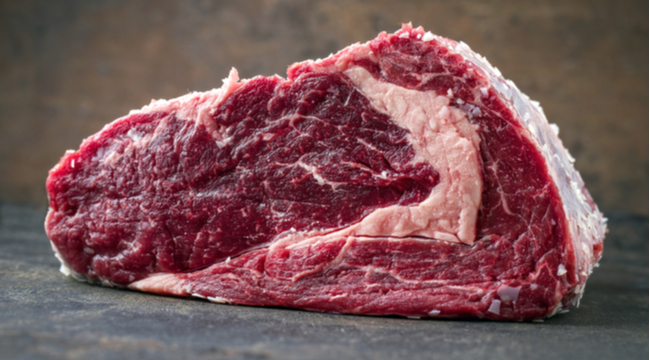
When it comes to steaks, there’s a mess of options that are, plainly, confusing. There’s a strip, New York strip, contre-filet, top sirloin, top loin, Kansas City strip, and so forth. Spoiler alert, those are just different names for the exact same cut! So, yeah, you’re allowed to be a bit mystified.
It’s best to think of a side of beef by how’s it broken down. What we’re looking at is small cuts of meat from the mid-back to rib areas. That goes down along the steer towards the tail, then cascades down the animal’s body towards its belly. This is called the loin.
Broadly, the subsections of the loin are called the short loin, sirloin, tenderloin, top sirloin (which is technically in the middle), bottom sirloin, and flank below it all. From these sections, we pull the bulk of every kind of steak you’ll find in the butcher’s shop or your grocery store. There are a few other steaks that come from other parts of the cow, but the majority is going to be in or around the loin area.
Tenderlion
https://www.instagram.com/p/BeENNrHDB5Z/
The Tenderloin is also known as a Châteaubriand (a big enough cut for two or three people), Filet, Filet mignon, or Fillet. The tenderloin section of the steer starts by cutting into the short loin and running below the sirloin. Hence, a porterhouse is just a tenderloin with a short loin still attached. But more on that one later.
Tenderloin is very low in fat but still butter soft. That lack of fat does have the downside of stripping a lot of flavor from the steak. So, you’re trading nourishing fat and flavor for delicate texture. That being said, tenderloins benefit the most from high-fat saucing options.
Strip
The Strip Steak is also known as a Contre-filet, New York Strip, Kansas City Strip, Top Sirloin, Top Loin, or Shell Steak (when on the bone). The name will depend on the genre and culture of the restaurant you’re at. Or if you’re in New York or Kansas City, evidently.
A Strip Steak comes from the short loin of the cow. And, just to make things that little bit more annoying, a strip has nothing to do with the sirloin section or the Sirloin Steak — which is an entirely different cut from the rump — even though a name for the steak is “top sirloin.” Then, of course, this all changes when you go to Britain and Australia. So, yeah, someone needs to gather all the beefeaters and make a final ruling on what to call this one.
To be as simple as possible: The short loin or strip is where the main section from the ribeye widens out and that fatty cap ends. The marbling is still there, but the lean is tighter and denser. Where a ribeye is light and almost airy, the strip is big and muscley with plenty of fat for flavor.
Ribeye
Ribeyes are also known as Entrecôte, Delmonico, Spencer, Scotch Fillet, and the very unfortunately named Tomahawk steak — which has a large section of rib bone left on it. The ribeye can be on the bone or off. Many prefer it on the bone as that’ll add flavor to the whole steak (think of a bone as insulation that helps keep moisture in).
Every ribeye has two main sections of steak: the central body of the steak and a fatty butter-like collar or cap with a nice layer of pure fat in between. The main body of the steak is the beginnings of the strip steak, which gets bigger as you move towards the loin. Whereas that fatty cap gets bigger and fattier as you move towards the neck, away from the loin. Steak excellence is finding that perfect balance of fatty, unctuous, melt-in-your-mouth cap surrounding well-marbled steak.
This is a melt in your mouth steak that tips the scales of lean versus fat to damn near even.
Tri-Tip
https://www.instagram.com/p/BeEl0KBhcMD/
The Tri-Tip or Santa Maria Steak is triangular cut from the bottom of the sirloin. This cut was popularized in California’s central valley and has traveled across the country well … in America. Of course, this cut has been used extensively everywhere else beef is eaten. It’s called an aiguillette baronne (baroness cut) in France and a Bürgermeisterstück in Germany. The latter literally means ‘the mayor’s piece.’ So if it’s good enough for a German mayor, it’s gotta be great, right?
It’s generally well marbled and fairly tender. The tri-tip holds the strange space between slow cooking and fast cooking when it comes to steaks. You can easily throw it over some fire for a short amount of time or slow cook it into an unctuous delight to fill your tacos to the brim. We’re sure someone from California’s central valley will have plenty of opinions about what the real right way is.
Porterhouse/T-Bone
The Porterhouse or Florentine steak and is the biggest of the steaks. A porterhouse is a two-fer with a piece of tenderloin next to a strip steak with a ‘t-shaped’ bone holding everything together.
The steaks are cut where the short loin begins. The forward portion of the cuts tends to be smaller and are called a ‘T-Bone Steaks.’ There’s a real method to the madness here. The difference between a “t-bone” and a “porterhouse” is that the tenderloin part has to be between a half an inch to one-and-a-half inches wide (that’s width from the bone to the edge of the meat, not thickness). To be called a porterhouse that tenderloin needs to be over one-and-a-half inches wide.
That’s a big ol’ steak. We really should only be ordering this to share with two to four people.
Flat Iron
A Flat Iron can also be called a Butlers’, Oyster Blade, Top Blade, or Boneless Chuck Steak. It comes from the top section of the chuck roast or forward shoulder section of the steer, nearest the neck.
The flat iron has a little marbling that brings a lot of flavors. It generally has a strip of fascia running through the section which means you can separate this cut into two flat or patio steaks. Overall, it’s a tender and a surprisingly cheap way to eat steak without sacrificing fatty nutrients.
Flank and Hanger
Flank, Bavette, or Sobrebarriga and Hanger or Butcher’s Steak are two different cuts, sure. But they’re very similar at the end of the day.
The flank comes from the lower, well, flank of the steer which is further back along the upper belly of the cow. The hanger comes from the plate section just before the flank.
Both cuts are high in connective tissue (muscle) and low in fat. They’re unique cuts that are generally dirt cheap but do lack in the fatty nutrients of more marbled cuts and, thereby, a lot of the flavor. These are the cuts you used to see sizzling on fajita skillets and in burritos. Today, they’ve been brought forward to help chefs keep costs down while still serving us steak. At the end of the day, you’ll need a nice sauce to make them pop.
THE DONE-NESS
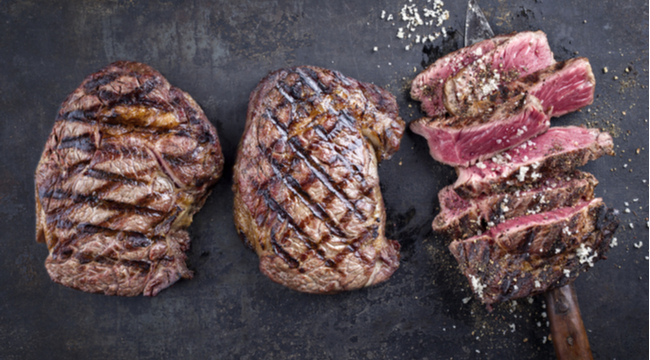
Steak, in general, is meant to be a fast-cooked protein, as opposed to a slow-cooked one. That is, steaks are ready within 5-15 minutes whereas a roast, chuck, or ham will take up the better part of the day (or more).
How you want your steak cooked really comes down to personal taste and particular palette. If you grew up with well-done steaks, you’re probably going to lean towards that done-ness. But tastes change and experimentation is the cornerstone of living your life as a gourmand.
Actual steak done-ness comes down to temperature. And, as we’ve pointed out before, the temperature you want your meat cooked to will determine how much myosin protein is left in the steak. That protein is what keeps the steak full of pink and moisture. When the myosin protein is cooked off, you’re left with actin proteins that make up the dry, brown steak that’s well done.
To be fair to well-done steak lovers, it really is a matter of taste and some people simply prefer the taste of actin protein over the taste of myosin protein. Much like the cilantro debate — some people taste soap, some people taste wonderful herbs — no one is really in the wrong here.
Tartar(e)
https://www.instagram.com/p/BeCAcu9nbhm/
This is raw. It actually did get its name from primarily being served with a tartare sauce (like fish & chips) throughout the 19th century. Today, you’ll find steak tartare served with generous amounts of spices, pickles, usually a raw egg yolk, and some nice toast to deliver all that goodness.
It’s imperative that you know where the beef is coming from if you’re ordering this style. Tartare is very commonplace outside America, where factory farming isn’t as pervasive. So the quality of the beef is a much higher standard across the board. Tartare is raw beef, remember. So the chances of the meat reaching 140F (when harmful bacteria dies) are zilch. It has to be handled in a way where harmful bacteria are not given a chance to attach themselves.
So, maybe try it on your next trip to Canada, Wisconsin, or Germany … or from a butcher you really trust.
Blue
https://www.instagram.com/p/BZ4U11_AcC2/
Have you seen Gangs of New York? You know that scene where Bill the Butcher barely sears off his steak then tucks in? Yeah, that’s blue. Blue means you’ve seared the outside of the steak to 120F. Basically, you have a sear on the outside just forming and the inside is still raw and cool.
It’s an acquired taste.
Rare
Rare steaks need to reach an internal temperature of 125F-130F. That means you’ll get that nice sear on the outside, but the inside will be very dark pink and just warmed through.
Medium Rare
This is probably the most commonly served doneness in the United States and what most chefs will aim for. Part of that reason is that medium rare means the steak has reached 140F; that means that all harmful bacterias have been eliminated.
The steak will still have a nice pinkness to it, be hot throughout, and have a solid sear.
Medium
This is where that myosin we walked about earlier starts to disappear rapidly. Medium means 150F and only a slight pink in the middle.
Medium Well
https://www.instagram.com/p/BLs9xZigc9j/
Medium well feels like a very persnickety order. It comes in at 155F with only a tiny bit less pink to it than medium. It’s basically only five degrees cooler than a well-done steak, but there’s still a hint of pink left and a tad of moisture clinging on.
Well Done
Well done is any steak that’s cooked to over 160F. Again, you’ve already entered the safe zone for bacteria 20 degrees earlier. So this isn’t any safer than eating a medium rare steak. However, almost all the myosin proteins are gone at this point and you’re left with a completely browned out and literally drier steak, full of actin proteins. That may just be your jam.
THE METHOD
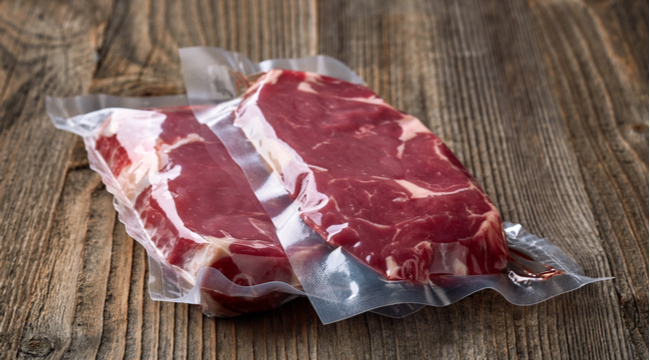
Generally, there’s no bad way to cook a steak. Well, we guess boiling is probably a bad idea, but who does that anyway?
The main ways you’ll cook a steak are over a flame, in a cast iron skillet, under a broiler, in sous vide, or some combination of these methods. Each possesses qualities that are fantastic and some possess qualities that — while delicious — do carry downsides.
Flame
Cooking a steak over wood or charcoal flame adds smoke and great flavors. It’s a very popular way to cook from Argentina to your backyard in Indiana.
The downsides to using a combustible fuel like wood and charcoal are two-fold. First, you’re losing precious fats to the fire. Second, you’re embedding toxic carcinogens from the smoke and ash of the fire into the meat. Of course, using a propane or natural gas flame does lower that prospect, but even in that case, you’re still losing all that fatty goodness to the bottom of the grill.
Still, if you want that lattice cross section of grill marks and a nice, smoky flavor spectrum in there, this is the way to go.
Skillet
Many would argue this is the best course of action. There’s a lot of reason why that’s correct.
The skillet allows you to cook your steak in a lot of butter and plenty of aromatics (think fresh sprigs of rosemary and cloves of garlic and the like). All of that combines with fats and juices from the meat. It just adds so much more flavor to the whole affair.
You’re also allowing for a full sear to happen across the broadest section fo the meat. Those lattice grill marks have nothing on a great skillet sear. Lastly, you can make a really fast pan sauce with the leftover butter and maybe a splash of wine to pour over your steak right before you serve it.
There’s little downside here.
Broil
https://www.instagram.com/p/BbNI_JCB4NZ/
Broiling is fairly popular in restaurants for getting a steak done while also getting it out of the way of the line. Overall, it’s probably the most boring as the top side heat source doesn’t bring a whole lot to the steak, taste-wise. Still, it’s efficient and brings along a great sear.
Often times restaurants will still sear a steak off on a grill or in a skillet and then bring it up to temp under the broiler. Again, this is mostly to keep the line moving as quickly and efficiently as possible. So, using this method at home is fine but largely unnecessary.
Sous Vide
https://www.instagram.com/p/Bd6IXxfh_M_/
This is one of the best ways to make a great steak and its popularity with home cooks is on the rise. You’ll need a sous vide, a basin, a bag, a little butter, and a great steak with some killer aromatics. This method allows you to bring the steak to an exact temperature consistently throughout the cut without losing any nutrients from evaporation. You’ll be left with the moistest and most flavorful steak possible.
Generally speaking, you’ll need to cook the steak about five degrees below your end game doneness. That’s so that when you sear the steak off in a skillet, it reaches the target temp at the end.
Once you go sous vide, it’ll be hard to go back to any other method. It really is that good.
THE SAUCES
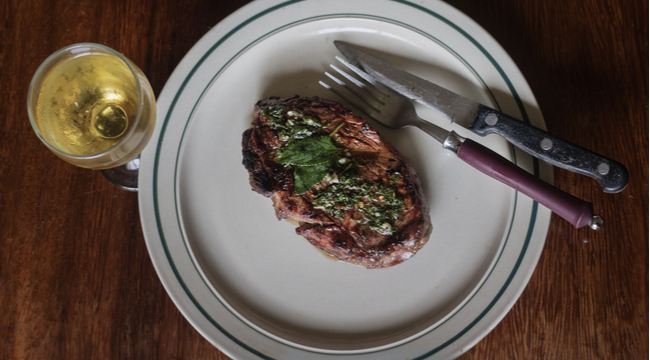
Which sauce to put on a steak is probably as controversial as to how well done you want your steak cooked. Everyone is going to have an opinion and everyone is probably going to be right for one reason or another — even if we’re talking a dollop of horseradish or the much (unfairly) maligned ketchup.
For us here at Uproxx, it comes down to you. Find a combo you love and go with that: Experiment, enjoy, and embrace. One rule: If you’re going with an expensive cut of meat — something marbled and graded — don’t sauce the steak directly. Let the meat sine and your diners sauce their own steaks.
Au Poivre
Au Poivre or Pepper Sauce is a classic mix of pickled green peppers, cracked peppercorns, butter, cognac, a splash of heavy cream, and the fond from a skillet that’s just cooked a steak. It’s creamy, tart, and lush with a nice punch of spice.
Au Poivre is best with a Tenderloin since the sauce is very fat-forward. A Flat Iron or Flank/Hanger works in a pinch. It’s a bit much for a porterhouse even though that’s just a strip and tenderloin together.
Gremolata
Gremolata is an Italian cousin of the chimichurri. It’s made with lemon zest, anchovies, parsley, and garlic. It’s bright and funky with a nice hit of garlic spice.
It’s best with a Hanger, Flank, or Flat Iron. But, if you’re in Florence, you’ll often get it with a Porterhouse (Florentine steak). So don’t limit yourself.
Béarnaise
Béarnaise is in the mayonnaise, tartare, and aioli world of sauces. It’s a (generally) cold sauce of butter, egg yolks, and vinegar — very close to a hollandaise — that’s then spiced with anything from shallots to tarragon to peppercorns. It’s creamy, rich, and more herbal than spicy (usually).
It’s heavy and needs to be an accent to the heavy-duty flavor. It works best when you’re adding fat to a Tenderloin or going hard on a Ribeye or Porterhouse. Though, if you’re doing a nice steak frites with a Flat Iron, you can’t go wrong either. What we’re saying is that this one’s versatile.
Chimichurri
Chimichurri tends to be a milder version of Gremolata. It’s a mix of parsley, garlic, olive oil, vinegar, and cilantro, oregano, or another green fresh herb. It’s more sharp than funky and serves as a counterpoint to the meat. There’s also a red version of that adds red pepper flakes and amps up the spiciness significantly.
It’s best served over any steak that’s fairly flavor-neutral (read: less fatty). So a Hanger, Flank, and Flat Iron steaks are the play here.
Gorgonzola
This one is for those of us who want big flavors met with equally big flavors. A nice, creamy gorgonzola or blue cheese sauce is made by reducing heavy cream and then adding in lots of funky cheese to the mix. It’s bold and heavy while still being delightful.
It’s best to go big or go home when you’re talking a blue cheese sauce. So pair it with a Ribeye, Tenderloin, Strip, or Porterhouse. The super tender steaks are the best bet here as you don’t want to use a heavy sauce like this with something you have to spend too much time chewing.
Port or Red Wine Reduction
https://www.instagram.com/p/Bda23ddDlHB/
Generally, you’ll be able to make this after you sear off your steak while it’s resting. There are a lot of ways to make a wine reduction, but one of the best is to simply add a few splashes of wine into a skillet with butter and herbs and let it reduce. Then you pour it over the steak. Simple, fast, delicious.
It’s best with Tenderloin, Ribeye, Strip, or Porterhouse. Let all those buttery fats blend with the tartness of the wine and you won’t be disappointed.
Teriyaki
The funky umami of the soy sauce along with a sweetness of brown sugar is a classic combination. Add in a little garlic, sake, sesame, and mirin … perfect. You get savory and the sweet mixing with a meat in ways that elevate without masking the flavor.
This is a bold flavor that’s not at all heavy. It’s often best used as a marinade or dressing sauce after the cook. Try it with cuts like Tri-Tip, Flank/Hanger, and Flat Iron. It also works wonders with a Strip as a marinade that helps create a caramel sear when you cook it.
Mole
Mole combines fruits like chilies with nuts, corn, and, often, cocoa. It’s a luscious sauce that should pack a delicious punch. It’s also often the star of the show given its complexity.
You’ll find mole works wonders with Hanger, Flank, Tri-Tip, and Flat Iron. Try it with a nice tenderloin and you’ll be delighted. It’s a bit too much for the fattier cuts.
Compound Butter
Compound butters are a chance to let fat plus flavor shine without losing the integrity of the steak. Basically, a compound butter is a butter whipped with flavor enhancers, compacted, and chilled. It’s a sort of proto-sauce that mixes with the juices and fats of the meat to make a well-rounded experience.
You need a fair amount of fat from the meat to get the best results from compound butter. So it’s best used with a Strip, Ribeye, or Porterhouse. Though, a great compound butter works well with a Tenderloin and Flat Iron too.






